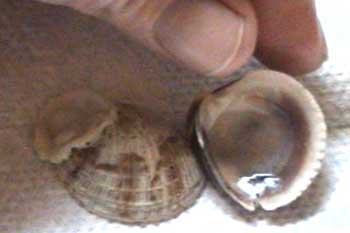

Terri K. Hathaway: In the top photo and on the left venus in the bottom photo, I think that you have an oyster shell on the cross-barred venus clams (Chione cancellata). Venus clams bury, they don't attach to other things. In the bottom photo, on the shell to the right, it looks like the bottom plates of barnacles, but I can't be sure from that photo.
Sharon: Many of these shell creatures (to my knowledge) reproduce a-sexually ... and I'm curious if that may help explain why they've changed so little over the millions of years. Perhaps it has nothing to do with, perhaps it does to some degree, --how different are cloning and a-sexual reproduction? Basically the same DNA is being passed from generation to generation, or perhaps not? And, where do they get their coloration from? Genetic, or the food they eat?Edward T. Babinski: About shelled-species, a lot of them reproduce sexually and lay eggs, and the new little hatchlings are free-swimming little critters without a shell, until after they settle down somewhere, gluing themselves to their new home-base and acquiring a shell. Barnacles do it that way. I figure clams, oysters and mussels do things that way too. Crabs and other crustacea have an exo-skeleton, not a "shell" in the sense in which clams and snails do.
Most species do not change considerably over millions of years because evolution is a branching process. In other words bacteria didn't become extinct once multi-cellular organisms arose.
Think of it this way, trees don't lose their roots as they grow up and out of the soil and start growing limbs and branches. Primates branched off into a number of larger brained species, including the extinct species, homo habilus, homo erectus, and homo neanderthalus. But even though larger brained primates like homo sapiens evolved, there are still monkeys and apes. By the way, Answers in Genesis warns modern day creationists in their article on "Arguments Creationists Should Not Use," not to bother using the argument, "If humans evolved from apes, why are there still apes?"
Sharon: Interesting. Starfish reproduce sexually and a-sexually, and have an exo-skeleton too.
Echinoderms are armored animals that have a hard exoskeleton made of interlocking calcium carbonate plates and spines. These slow-moving creatures have a water-vascular system (a rudimentary circulatory system), water-filled channels that go through the body. The oldest-known fossil echinoderm is Arkarua, which lived in pre-Cambrian times, during the Vendian period, roughly 560 million years ago, in what is now Australia.
Some echinoderms include sea stars (also called starfish), brittle stars (which includes basket stars), sea cucumbers, sea urchins, sand dollars, and crinoids (also called feather stars, which have a soft body surrounded by upwards-facing arms). Classification: Kingdom Animalia (animals), Phylum Echinodermata.
Echinoderm
Starfish: First submission
Starfish may reproduce either sexually or asexually. When asexual reproduction takes place, the animal breaks itself into two pieces. ...
Star Fish
asexual reproduction@Everything2.com
Many plants and 'lower animals' reproduce both sexually and asexually; there are some ... When environmental conditions become favourable, the outer shell ...
Reproduction
Sharon: I have noticed some of the shells within a species have nearly identical colors and markings, while other species have shells with a variety of colors / markings.Terri K. Hathaway: Some markings and colors are under genetic control. The coloration of other species are dependent on their diet, so there can really be no generalizations about marking and colors
Sharon: do any shelled animals that you are aware of, reproduce a-sexually?Terri K. Hathaway: You need to be specific when you talk about "shelled" animals to make sure everyone is on the same page -- we're talking about the phylum Mollusca. Sometimes people refer to shellfish when talking about seafood -- most of the time the term "shellfish" refers to molluscs, like oysters and clams, etc. and to crustaceans (crabs, shrimp, etc.) which are arthropods, not molluscs.
I don't know of any molluscs that reproduce asexually, but I could be mistaken.
Edward T. Babinski: About shelled-species, a lot of them reproduce sexually and lay eggs, and that the new little hatchlings were free-swimming little critters without a shell, until after they settled down somewhere, gluing themselves to their new home-base and acquiring a shell. Barnacles do it that way. I figured clams, oysters and mussels did things that way too. Crabs and other crustacea have an exo-skeleton, not a "shell" in the sense in which clams and snails do.Terri K. Hathaway: Again, be careful about referring to "shelled species" -- barnacles are crustaceans, like crabs and shrimp.
With reproduction, molluscs have external fertilization (with broadcast spawning where eggs and sperm are shed into and mix in the water column) and internal fertilization. Some species do it one way, others another. Some species are monoecious (both sexes in one organism); others are dioecious (male and female in separate organisms). I think they're very complicated!
Sharon: Starfish reproduce sexually and a-sexually, and have an exo-skeleton too.Terri K. Hathaway: Sea stars belong to the phylum Echinodermata -- they're neither molluscs nor arthropods -- a different group of animals!
Terri K. Hathaway
Marine Education Specialist
North Carolina Sea Grant
http://www.ncseagrant.org/



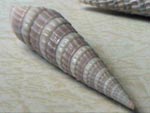

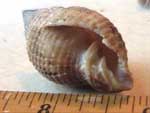





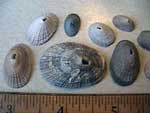

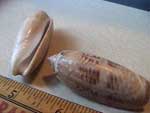
1 comment:
There is a wonderful sea shell museum near Sanibel Fl that has a film that gives great info. Sea Shells leave casings and in casings are baby sea shells!!
It also explains how they move and what they eat. I wish I had known this for my high school science project on sea shells.
Post a Comment